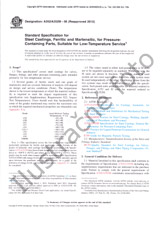Potrebujeme váš súhlas na využitie jednotlivých dát, aby sa vám okrem iného mohli ukazovať informácie týkajúce sa vašich záujmov. Súhlas udelíte kliknutím na tlačidlo „OK“.
ASTM D243/D243M-20
Standard Test Method for Residue of Specified Penetration
NORMA vydaná dňa 1.11.2020
Informácie o norme:
Označenie normy: ASTM D243/D243M-20
Poznámka: NEPLATNÁ
Dátum vydania normy: 1.11.2020
Kód tovaru: NS-1009562
Počet strán: 3
Približná hmotnosť: 9 g (0.02 libier)
Krajina: Americká technická norma
Kategória: Technické normy ASTM
Kategórie - podobné normy:
Anotácia textu normy ASTM D243/D243M-20 :
Keywords:
asphalt, cutback, penetration, residue, road oil ,, ICS Number Code 93.080.20 (Road construction materials)
Doplňujúce informácie
| Significance and Use | ||||||||||||||
|
5.1 This test method is used to determine the percentage of residue having a specified penetration at 100 g/5 s at 25 °C [77 °F]. This test method provides a residue for quality control or for use in other tests as desired. Note 1: The quality of the results produced by this standard
are dependent on the competence of the personnel performing the
procedure and the capability, calibration, and maintenance of the
equipment used. Agencies that meet the criteria of Specification
D3666 are generally
considered capable of competent and objective testing, sampling,
inspection, etc. Users of this standard are cautioned that
compliance with Specification D3666 alone does not completely ensure
reliable results. Reliable results depend on many factors;
following the suggestions of Specification D3666 or some similar acceptable
guideline provides a means of evaluating and controlling some of
those factors.
|
||||||||||||||
| 1. Scope | ||||||||||||||
|
1.1 This test method is used to thermally reduce cutback asphalt, a road oil or a semisolid asphalt, having a penetration greater than 100, to a residue of specified penetration. It is primarily used with slow-curing cutback asphalt as specified in Specification D2026/D2026M. 1.2 The values stated in either SI units or inch-pound units are to be regarded separately as standard. The values stated in each system are not necessarily exact equivalents; therefore, to ensure conformance with the standard, each system shall be used independently of the other, and values from the two systems shall not be combined. 1.3 Warning—Mercury has been designated by the United States Environmental Protection Agency (EPA) and many state agencies as a hazardous material that can cause central nervous system, kidney, and liver damage. Mercury, or its vapor, may be hazardous to health and corrosive to materials. Caution should be taken when handling mercury and mercury-containing products. See the applicable product Material Safety Data Sheet (MSDS) for details and EPA’s website—http://www.epa.gov/mercury/—for additional information. Users should be aware that selling mercury, mercury-containing products, or both, into your state may be prohibited by state law. 1.4 The text of this standard references notes and footnotes which provide explanatory material. These notes and footnotes (excluding those in tables and figures) shall not be considered as requirements of the standard. 1.5 This standard does not purport to address all of the safety concerns, if any, associated with its use. It is the responsibility of the user of this standard to establish appropriate safety, health, and environmental practices and determine the applicability of regulatory limitations prior to use. 1.6 This international standard was developed in accordance with internationally recognized principles on standardization established in the Decision on Principles for the Development of International Standards, Guides and Recommendations issued by the World Trade Organization Technical Barriers to Trade (TBT) Committee. |
||||||||||||||
| 2. Referenced Documents | ||||||||||||||
|




 Cookies
Cookies
